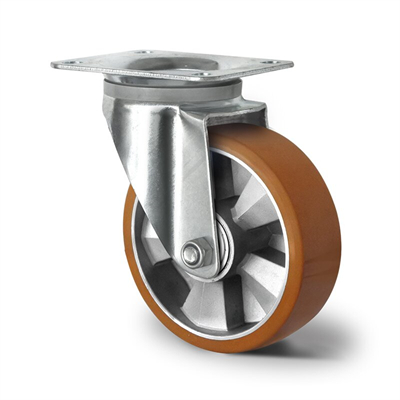Improving load distribution with rigid casters is crucial to maintain stability, reduce wear and tear on equipment, and prevent overloading or tipping. Here are some strategies to enhance load distribution when using rigid casters:
- Use the Correct Number of Casters: Ensure that the equipment or load is supported by an appropriate number of rigid casters. Distributing the load evenly among the casters helps prevent overloading and uneven weight distribution.
- Distribute the Load Uniformly: When placing items on a cart or equipment, distribute the weight as evenly as possible across the casters. Avoid concentrated loads on a single caster, as this can lead to instability and premature wear.
- Proper Mounting and Positioning: Install rigid casters at the correct positions to evenly distribute the load. Follow manufacturer recommendations for caster placement to optimize load distribution.
- Select the Right Casters: Choose rigid casters with a load capacity that matches or exceeds the weight of the load you intend to transport. High-capacity casters are designed to handle heavy loads while distributing the weight effectively.
- Balanced Load Height: Ensure that the center of gravity of the load is as low and as close to the center of the equipment as possible. A lower center of gravity enhances stability, while a balanced load height minimizes tipping risks.
- Check Caster Spacing: If you’re dealing with long or wide loads, consider the spacing between casters. A longer distance between casters can improve load distribution and stability.
- Maintain Proper Inflation: If your equipment has pneumatic tires, ensure that they are properly inflated. Over-inflated or under-inflated tires can affect load distribution and caster performance.
- Monitor Wheel Condition: Regularly inspect the wheels of your rigid casters for signs of wear or damage. Damaged wheels can cause uneven load distribution, leading to instability and reduced caster performance.
- Reduce Impact and Shock: Minimize sudden impacts or shocks to the load or equipment, as these can affect load distribution and caster performance. Slow down when maneuvering, especially with heavy loads.
- Maintain the Floor Surface: Ensure that the floor or ground surface is level and free from debris that could affect load distribution and caster performance.
- Consider Wheel Materials: Select caster wheels made of materials suitable for the specific environment and load. Some materials may provide better load distribution, reduce vibration, and improve traction on different surfaces.
- Additional Load Distribution Accessories: Depending on your application, you may use load distribution pads or plates under the load to evenly spread the weight across the casters.
- Regular Maintenance: Implement a routine maintenance schedule to inspect and maintain your rigid casters. Clean the wheels and lubricate moving parts as needed to optimize performance and load distribution.
Proper load distribution is essential for preventing equipment damage, maintaining safety, and ensuring the longevity of rigid casters. By following these strategies, you can improve load distribution and promote stability when using rigid casters in various applications.


